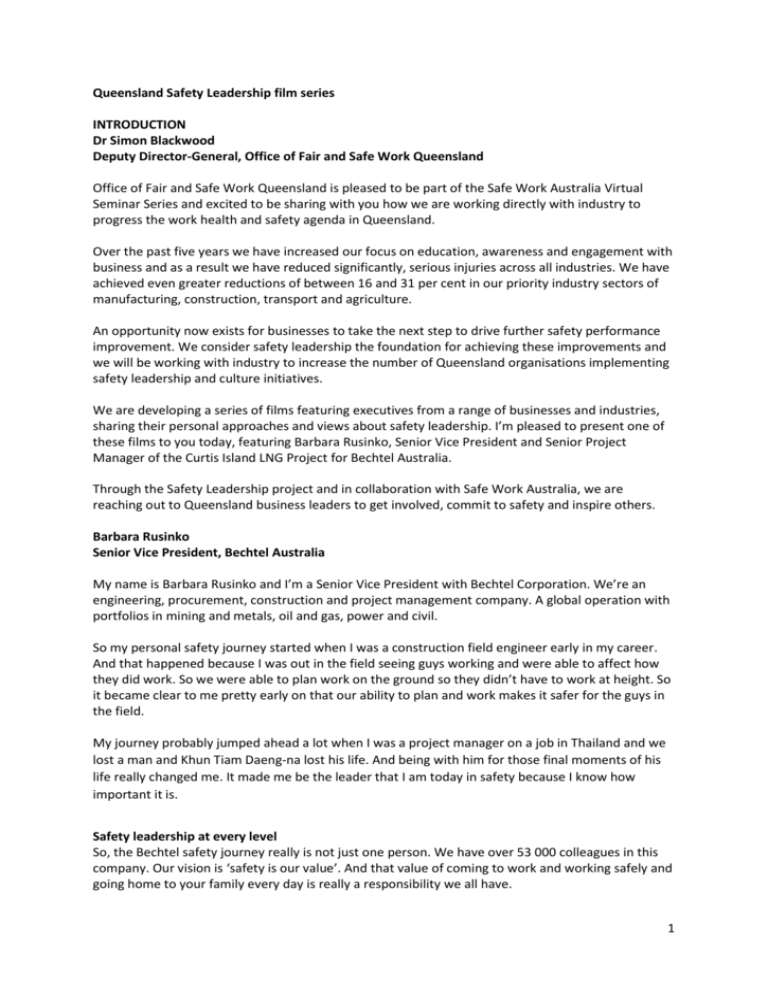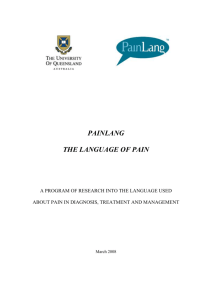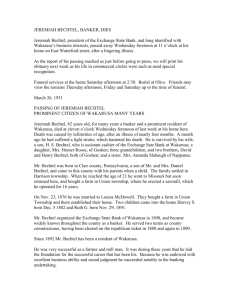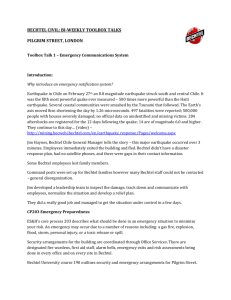Queensland Safety Leadership film series
advertisement

Queensland Safety Leadership film series INTRODUCTION Dr Simon Blackwood Deputy Director-General, Office of Fair and Safe Work Queensland Office of Fair and Safe Work Queensland is pleased to be part of the Safe Work Australia Virtual Seminar Series and excited to be sharing with you how we are working directly with industry to progress the work health and safety agenda in Queensland. Over the past five years we have increased our focus on education, awareness and engagement with business and as a result we have reduced significantly, serious injuries across all industries. We have achieved even greater reductions of between 16 and 31 per cent in our priority industry sectors of manufacturing, construction, transport and agriculture. An opportunity now exists for businesses to take the next step to drive further safety performance improvement. We consider safety leadership the foundation for achieving these improvements and we will be working with industry to increase the number of Queensland organisations implementing safety leadership and culture initiatives. We are developing a series of films featuring executives from a range of businesses and industries, sharing their personal approaches and views about safety leadership. I’m pleased to present one of these films to you today, featuring Barbara Rusinko, Senior Vice President and Senior Project Manager of the Curtis Island LNG Project for Bechtel Australia. Through the Safety Leadership project and in collaboration with Safe Work Australia, we are reaching out to Queensland business leaders to get involved, commit to safety and inspire others. Barbara Rusinko Senior Vice President, Bechtel Australia My name is Barbara Rusinko and I’m a Senior Vice President with Bechtel Corporation. We’re an engineering, procurement, construction and project management company. A global operation with portfolios in mining and metals, oil and gas, power and civil. So my personal safety journey started when I was a construction field engineer early in my career. And that happened because I was out in the field seeing guys working and were able to affect how they did work. So we were able to plan work on the ground so they didn’t have to work at height. So it became clear to me pretty early on that our ability to plan and work makes it safer for the guys in the field. My journey probably jumped ahead a lot when I was a project manager on a job in Thailand and we lost a man and Khun Tiam Daeng-na lost his life. And being with him for those final moments of his life really changed me. It made me be the leader that I am today in safety because I know how important it is. Safety leadership at every level So, the Bechtel safety journey really is not just one person. We have over 53 000 colleagues in this company. Our vision is ‘safety is our value’. And that value of coming to work and working safely and going home to your family every day is really a responsibility we all have. 1 It’s good business practice to have a safe operation. Our colleagues and our customers rely on us to have a safe operation and make sure our folks go home every day so there is no inconsistency and there is no battle between the business and running the project and keeping people safe. I am never going to say Bechtel is ahead of the game in safety. I think we do an admirable job, but I’m never going to be satisfied that we are the best we can ever be until we do have zero incidents on our job sites. Safety challenges in construction projects The challenge when you have a job that goes on for several years and you have a workforce that transitions over and over again, you really need to count on your basics. You need to make sure your safety inductions are solid, and that all of our follow up communications with the folks out in the field are consistent and they have the same approach. That’s the main thing we can do in order to— as we have turnover with personnel. Quality communication in safety I think middle managers probably have the toughest job of all when it comes to safety. We need to have them operate in a bi-directional basis. They need to take the messages that leadership is sending about how important safety is on the job and translate that down to the workforce. And at the same time, they need to take the issues and the concerns of the workforce up to management to get those things resolved. And the workforce needs to trust in these middle managers to be able to deliver that message. We have some, what I call tools of our trade, that we use for communicating safety things. We have pre-starts every single day that go out with a message the night before, so supervisors can look at them ahead of time and deliver those safety topics. We have close-outs at the end of every day, again for them to get their group back together before they go home and talk about lessons learned. And we also provide our supervisors with toolbox talks. So these are more detailed safety communications that they can use with their teams when they are about to embark on a new or different kind of work activity. Valuing safety participation The key thing with all of those is it’s not a one way lecture. Each one of those needs to be done in an interactive way where the workforce can also speak out and they get to share the lessons learned amongst themselves. One of the challenges we have of getting folks involved in safety and keeping their interest active is to get the folks who have a passion for it and give them an opportunity to shine. So on our projects we take full advantage of our health and safety reps. They were elected by the workforce within their discipline and we have integrated them into work processes that we know need improvement and change. So that’s one way we get them involved in our work. I think the other key thing is our people-based safety initiative. At peak, we had over 200 observers who go out and do peer-to-peer interactions on safety, and that provides a really good opportunity for one-to-one communication and it gets the employees actively engaged in the safety of their team mates as well. Building safety leadership capability Initially I would have thought that when you talk about developing safety capacity it’s a technical skill set, but it really isn’t. I think the two most important skills that we can give people are communication skills and planning skills. We want to be able to teach people how to communicate 2 so they feel comfortable going out in the field and stating a safety intervention if they see something that’s not safe. We also want them to be able to get in front of a group of people and talk about important safety things. The issue about planning is, I have seen most of our incidents happen when we’re doing short time work, things that haven’t been planned effectively. So we want to be able to give people the planning skills, to give them the opportunity to look at the task, identify the hazards and then put some measures in place to prevent incidents and injuries from happening. The importance of leadership style I don’t think there’s one leadership style that works for safety. If we’re trying to develop a team and get them behind this safety message that we want—leadership from the top down—you really want a collaborative, coaching kind of style. That’s going to get people around the table and develop that one team message that we have about safety. But sometimes when there’s an incident or something that needs immediate corrective action you do need to have a leader that has a little bit more discipline and a more direct style. So I think there’s an opportunity to use all our leadership skills when it comes to safety. I think the way we motivate our folks on the job, both at the craft level and our leadership is really to get them to take it personally on board. I want every one of them to know that instances regarding safety can have consequences that can’t be undone and they need to be able to make it personal. Once they’ve done that, then they’ll be much better able to look out after their mates and make sure that they go home safely. Be relentless I think my advice would be, be relentless. This is a subject where you can’t just do it on a part time basis. Their message has to be absolutely consistent to your leaders and to your workforce and you can’t compromise. Safety has to be the value that goes before all else. 3











